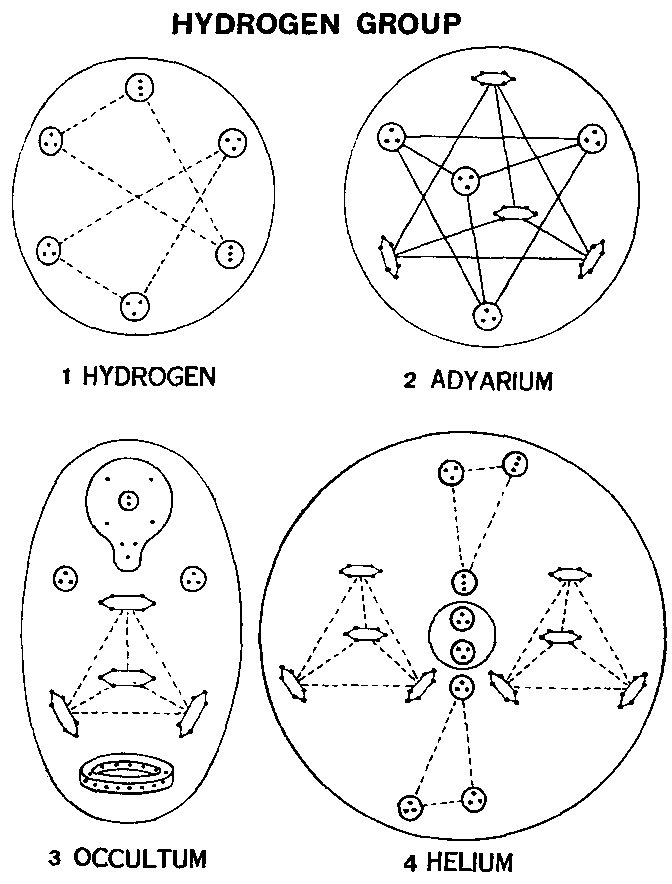
FIG. 16
THE HYDROGEN GROUP
INTRODUCTORY
WE come now to the more detailed study of the elements, and shall consider the atoms in their groups according to the Periodic classification, using the pendulum diagram.
As has already been pointed out, the Anu group themselves into seven definite forms or types, though each chemical atom is surrounded by a sphere wall of the surrounding material, forming a sphere of influence. There are a few exceptions which are ovoid in shape.
Into the seven types the Anu are packed in a beautiful and ingenious fashion., On examining the internal structure of the atoms we find more or less complicated groups capable of separate, independent existence on the E4 level. These may be dissociated into yet simpler groups on the E3 level and again into groups at the E2 level until we arrive at the single ultimate physical atom or Anu.
The diagrams can give only a very general idea of the facts they represent. They give groupings and show relationships, but much effort of the imagination is needed to transform the two-dimensional diagram into the three dimensional object. The student should try to visualize the figure from the diagram. Thus the two triangles of Hydrogen are not in one plane; the circles are spheres and the Anu within them, while preserving to each other their relative positions, are in swift movement in three dimensional space.
Where five Anu are seen they are generally arranged with the central Anu above the four, and their motion indicates lines which erect four plane triangles meeting at their apices, on a square base, forming a square-based four-sided pyramid.
It is found that many of the groups in which the Anu are arranged constantly recur and are therefore common to many atoms, forming, as it were, the bricks or fundamental patterns from which their structures are built. The composition of each atom. therefore, can be expressed in terms of these constituent groups.
By this means the relationships between the elements in
a given main group, and their similarities with other groups, is brought
out. A method has been devised by which all the elements can be expressed
in an algebraic formula by which the reader may realize the structure of
the atoms as they are built up out of their constituent groups. Each constituent
group is named after the first element in which it occurs. The letters
indicating the element are followed by a number indicating the number of
Anu in the group. Thus the Nitrogen 'balloon'becomes N 110 and the Lithium
spike is represented by Li 63.
36 OCCULT CHEMISTRY
When the elements are analyzed in this way we can see how they are built up. In some cases alternative nomenclature is possible. We have endeavoured to select those constituent groups which best bring out the relationships. The method is used, too, in the large condensed diagrams and where the heavier elements would require too large a diagram if drawn in full.
From the list of all the elements, given at the end of the book, it can be seen that Hydrogen. Oxygen, Nitrogen and Fluorine, which appeared to be so different from the rest in their external forms, contain characteristic groups which form part of many other elements. From this list, too, we can follow the changes as the elements succeed one another in weight.
Each dot in a diagram represents a single Anu. The enclosing lines indicate the impression of form made on the observer and the groupings of the Anu. The groups will divide along these lines when the element is broken up, so that the lines have significance but they do not exist as stable walls or enclosing films but rather mark limits, not lines, of vibration.
It should be specially noted that the diagrams are not drawn to scale, as such drawings would be impossible in the given space. The dot representing the Anu is enormously too large compared with the enclosures, which are absurdly too small; a scale drawing would mean as almost invisible dot on a sheet of many yards square.
So far as a chemical atom is concerned it does not matter whether it be drawn for investigation from a solid, a liquid or a gas; the atom does not alter its constitution by changing its state.
The internal arrangements of the atoms become much more complicated as they become heavier, as can be seen, for instance, is the complex arrangement necessitated by the presence of the 3,546 Anu contained in the chemical atom of Gold, as compared with the simple arrangement of the 18 Anu is Hydrogen.
THE HYDROGEN GROUP
Before the pendulum begins its swing we find four elements; Hydrogen, Adyarium, Occultum and Helium. Hydrogen is the lightest element known to science. Adyarium and Occultum were first observed by clairvoyance. Helium is one of the rare gases and is usually associated with Argon. It does not conform to the shape of the inert gases, however, though it has some constituents in common. It is therefore grouped with the earlier, lighter elements. All four of these are ovoid in external shape.
|
|
|
|
|
|
|
|
Hydrogen | (2H3' + H3) + (3H3) |
|
|
|
Adyarium | 4H3 + 4 Ad6 |
|
|
|
Occultum | 2H3 + Ad 24 + Oc15 + Oc 9 |
|
|
|
Helium | 2H3 + (2H3' + H3) + (3H3) + 2Ad24 |

FIG. 16
38 OCCULT CHEMISTRY
ATOMIC NO. 1. HYDROGEN
Hydrogen was the first chemical element examined and has already been discussed in Chapter 1. The Hydrogen atom consists of 18 Anu arranged in 6 groups, each of 3 Anu, all contained in an oval form. The six groups are at six points in space; each of the three groups making one half of Hydrogen are linked to each other across space by lines of attraction. We have thus the appearance of two interlaced triangles. Figs. 1 and 15 show the details and linking.
Hydrogen atoms were not observed to move in pairs.
In 1908 diagrams were given of the two halves of Hydrogen, but no record was then made of the types of Anu, positive or negative, within each group of three. It was then presumed, from the general appearance of the groups, that all Hydrogen atoms were alike. In 1932, however, during a more detailed examination of the two Hydrogen atoms in a molecule of water, a second variety of Hydrogen was discovered.
Hydrogen Variety 1 is composed of two halves, a positive and a negative. On examiningFig. 16 it will be seen that the positive half or triangle is composed of 5 positive Anu and 4 negative, thus making it preponderatingly positive; and that the negative half or triangle is composed of 5 negative Anu and 4 positive, thus making it preponderatingly negative.
The six groups are not all alike; they each contain three Anu. but in four of the groups the three Anu are arranged in a triangle, and in the remaining two in a line. To these small groups we have given the identifying symbols H3 and H3'.
In one large triangle all the three small groups have their Anu in the form of a triangle, while in the other large triangle two of the groups of three Anu are in a straight line and one in the form of a triangle. In the first edition of Occult Chemistry the two linear triplets are shown as being one in each triangle. Fig. 2. This variety was not observed by Mr. Leadbeater in 1932 and appears to be rare. The common variety is that described above and shown in Fig. 16.
Hydrogen Variety 2 differs in the number of positive and negative Anu forming the atom. In the first variety there are a total of 9 positive and 9 negative Anu, in the second variety we find 10 positive and 8 negative. This variety is therefore predominatingly positive. Fig. 17.
In the molecule of water. H20, one Hydrogen atom is of the first variety and the other of the second variety.
Hydrogen = (2H3' + H3) + (3H3)
| 6 spheres of 3 Anu |
|
|
|
|
|
|
||||
|
|
||||
|
|
|
|
|
|
|
|
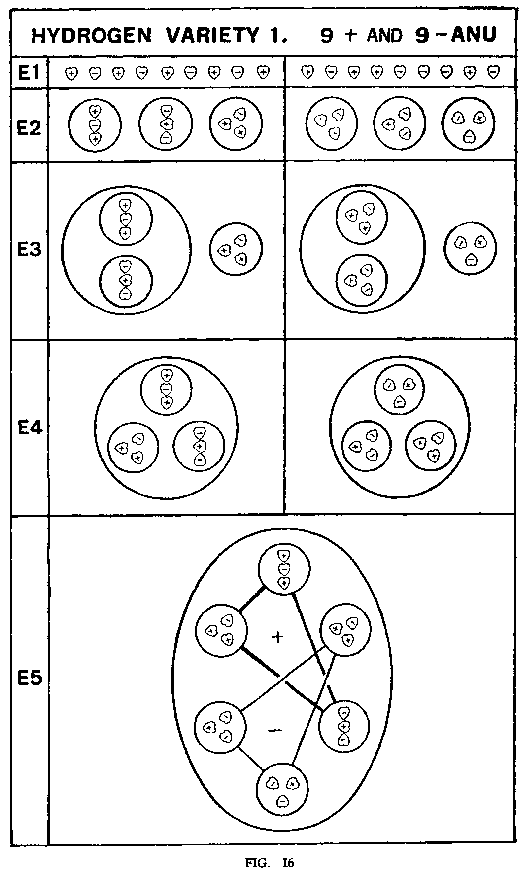
FIG. 16
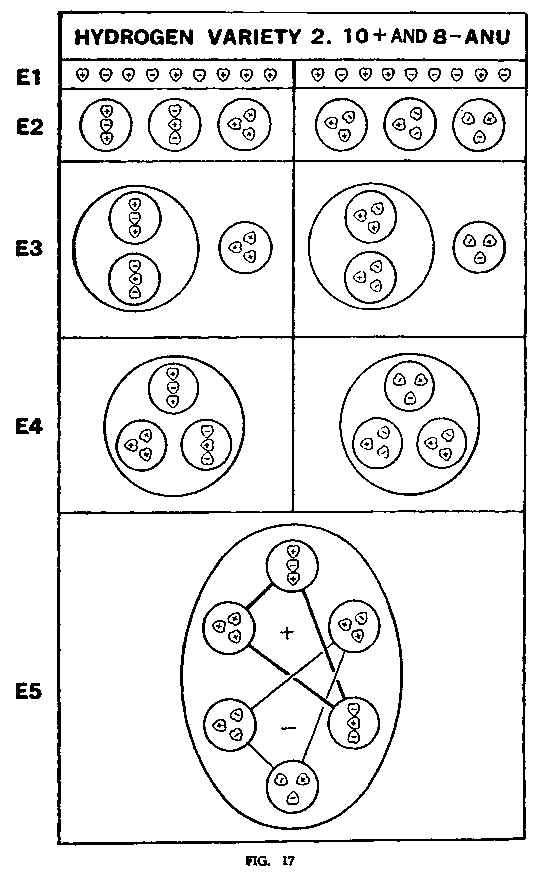
FIG. 17
THE HYDROGEN GROUP 41
Deuterium. During observations on the electrolysis of water a very few examples of two Hydrogen atoms united in a temporary alliance were seen. These two atoms were of varieties 1 and 2 and placed themselves at right angles to each other as in Fig. 18. This group of two Hydrogen atoms would have double the weight of ordinary Hydrogen, as is required for Deuterium.
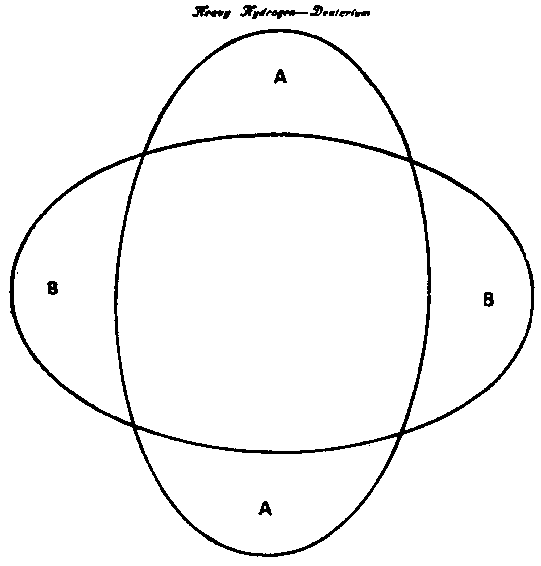
FIG. 18
42 OCCULT CHEMISTRY
ATOMIC No. 1A.
ADYARIUM
The discovery of this very light gas of atomic weight 2 (H=I), was announced in The Theosophist, December 1932. The external shape of the atom is spherical and it consists of 36 Anu. Twelve of these are divided into four groups of H3, one of which is placed at each of the four corners of a tetrahedron. Interlaced with this tetrahedron is a second containing four groups of six Anu. Fig. 15. Here we meet two forms which occur very often. First the group of six Anu arranged in the shape of a 'cigar' or elongated hexagon or prism. This we distinguish as Ad6. This form revolves with extreme rapidity around its longitudinal axis, and looks like a pencil sharpened at both ends. It appears to be strongly coherent, for, as will be seen later, its six Anu remain attached to each other on the E3 level, and even when divided into triplets on the E2 level these revolve around each other.
In Adyarium four of these prisms are placed at the corners of a tetrahedron, thus forming the larger group which also occurs very often and which is distinguished as Ad 24.
It will be seen that the two groups of four bodies each form tetrahedrons, that is to say, their respective positions in space, as they individually revolve within the sphere-wall of the element, are those marked out by the eight corners of two interlaced tetrahedrons.
Adyarium is rare in the atmosphere at the earth's surface, but it exists in greater quantity in the stratosphere. Like Hydrogen, it is being slowly lost to our atmosphere by radiation during the earth's journey round the Sun. But the rays of light from the Sun are combining sub-elements all the time, and the lost elements are being replaced by the new creations.
As this element was first observed by clairvoyant magnification at Adyar, we have called it Adyarium.
Adyarium = 4 H3 + 4 Ad6 or Ad12 + Ad24
| 4 H3 |
|
|
Anu | |
| 4 Ad6 |
|
|
" | |
|
|
||||
|
|
|
|
Anu | |
|
|
||||
| Number weight |
|
|
|
|
|
|
THE HYDROGEN GROUP 43
ATOMIC NO. 1B.
OCCULTUM
Occultum was first observed in 1895 and, finding that it was so light and so simple in its composition, it was thought that it might be Helium, of which it was not possible at that time to obtain a sample. When, however, Helium itself came under observation in 1907, it proved to be quite different from the object previously observed so the gas observed in 1895 was called Occultum, until orthodox science should find it
This element consists of 54 Anu and contains groups from Hydrogen and Adyarium. It is ovoid in shape. Fig. 15.
We here meet the tetrahedron, Ad 24, as in Adyarium. Above the tetrahedron is a balloon-shaped figure, Oc9, apparently drawn into shape by the attraction of the tetrahedron. The body below the tetrahedron looks like a coil of rope, and contains fifteen Anu. Oc15. They are arranged on a slanting disc in a flat ring and the force goes in at the top of one Anu, and out of the bottom of it into the top of the next. and so on, making a dosed circuit. The two little spheres, each containing a triplet, are like fill-up paragraphs to a compositor--they seem to be kept standing and popped in where wanted.
The constituents of Occultum reappear in Gold and other elements.
Occultum = 2 H3 + Ad 24 + Oc15 + Oc 9.
| Tetrahedron |
|
24 | Anu | |
| Balloon |
|
9 | " | |
| Triplets |
|
6 | " | |
| Ring |
|
15 | " | |
| ---- | ||||
| Total |
|
54 | Anu | |
| ---- | ||||
|
|
||||
| Number weight |
|
|
3.00 | |
|
|
THE HYDROGEN GROUP 45
ATOMIC NO. 2
HELIUM
Helium is different in configuration from the other inert gases. It is made up of the whole of Hydrogen and a good deal from Adyarium. It is ovoid in shape and not in the form of a six-pointed star as are the other inert gases, and it is therefore included in this preliminary group. Fig. 15 shows that the four elements in this group are closely related.
The two triangles of Hydrogen appear in Helium and two Ad 24 tetrahedrons. The tetrahedrons revolve round an egg-shaped central body consisting of two H3 spheres, and the triangles spin on their own axes while performing a similar revolution. Helium is completely balanced, that is to say, it is seemingly self-sufficient; a positive tetrahedron of 4 Ad6 groups is counterbalanced by a similar tetrahedron which is negative. A positive half of Hydrogen is satisfied with a negative half and in the centre of all the two groups of 3 Anu, being positive and negative, satisfy each other.
The whole has an attractive airy appearance, as of a fairy element.
Helium = 2H3 + 2 Ad24 + (2H3' + H3) + (3H3)
| Centre |
|
6 |
|
|
| 2Ad24 |
|
48 |
|
|
| 2 Triangles |
|
18 |
|
|
|
|
|
72 |
|
|
|
|
||||
| Number weight |
|
|
4.00 | |
|
|
HYDROGEN
On the E4 level the six bodies contained in the gaseous atom instantaneously re-arrange themselves within two spheres; the two linear triplets unite with one triangular triplet, holding to each other relative positions which, if connected by three straight lines, would form a triangle with a triplet at each angle, the remaining three triangular triplets similarly arrange themselves in the second sphere. These form the E4 compounds of Hydrogen.
In the dissociation of these to the E3 level, each sphere breaks up into two, the two linear triplets joining each other and setting free their triangular comrade. Two of the triangular triplets similarly remain together, casting out the third, so that Hydrogen yields four E3 compounds.
On the E2 level, the connexion between the double triplets is broken, and they become four independent groups, two remaining linear, but rearranging their internal relations; the two remaining groups are triplets.
The final dissociation sets all the Anu free. Figs 16
and 19.
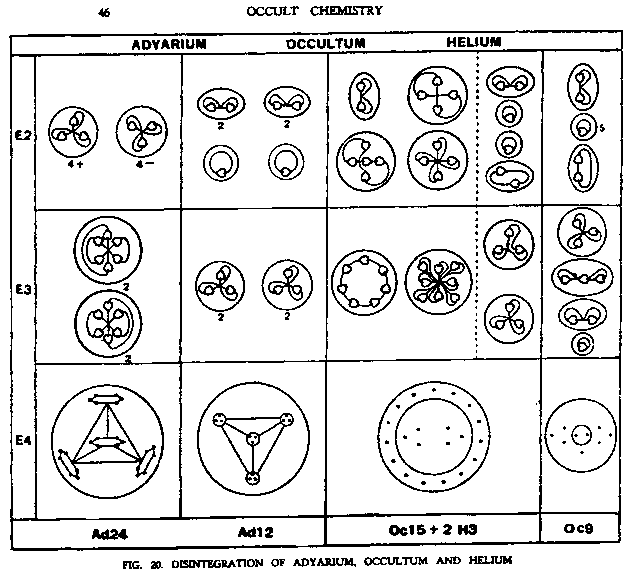
FIG. 20 DISINTIGRATION OF ADYARIUM, OCCULTUM AND HELIUM
THE HYDROGEN GROUP 47
DISINTEGRATION OF ADYARIUM
On the E4 level Adyarium sets free the two tetrahedrons Ad24 and Ad12.
On the E3 level the Ad24 gives 4 sextets, 4 Ad6, two positive and two negative; while the Ad12 gives 4 triplets.
On the E2 level each Ad6 gives two triplets, making 8 triplets in all.
The triplets from the Ad12 each give a duad and a unit, thus liberating four duads and four units.
DISINTEGRATION OF OCCULTUM
The tetrahedron, Ad24, acts as in Adyarium on the E4 level and separates as a whole, with its 4Ad6, flattening itself out within its hole. Two of the Ad6 are positive and two negative.
On further dissociation to the E3 level, the Ad6 go off independently, showing two types. These again divide into triplets on the E2 level.
The ring, Oc15, becomes a ring within a sphere and the two triads 2H3, which are loose in the gaseous atom, come within this ring. On the E3 level the ring casts out the two triads, which become independent triplets, and the ring breaks into two, a close ring of seven Anu and a double cross of eight.
These subdivide again to form E2 compounds, the ring yielding a quintet and a pair, and the double cross separating into its two parts.
The two triplets each cast out an Anu on dissociation to E2 and form two pairs and two units. .
The balloon, Oc9. On the E4 level the balloon becomes a sphere. On the E3 level it is much divided, the cohesion of its parts being slight. It forms two triplets, a pair and a unit. On the E2 level these set free, on further dissociation, no less than five separate Anu and two duads.
DISINTEGRATION OF HELIUM
Helium, being composed of the constituents of Hydrogen, Adyarium and Occultum, breaks up as do these elements.
On the E4 level we find two spheres each containing three triplets as in Hydrogen and two tetrahedrons, Ad24. In addition there is a globe containing two small spheres, 2 H3.
On the E3 level the Hydrogen triplets break up as it Fig. 19 and the two Ad24 as shown in Fig. 20. The globe containing the two H3 liberates the two triplets on the E3 level.
On the E2 level the disintegration proceeds as shown in Figs. 19 and 20.